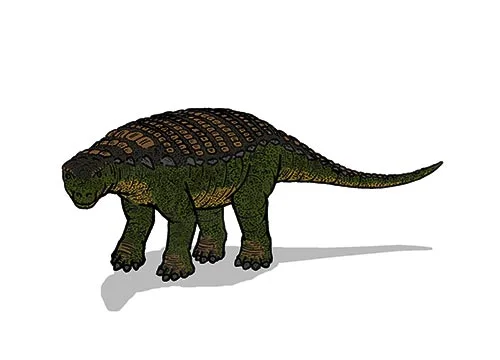Nodosaurus (Knobbled lizard)

No-doe-sore-us
Othniel Charles Marsh - 1889
Herbivore
Estimated 4-6 meters long
Armoured Dinosaur
N. textilis (type)
USA, Wyoming & Kansas
Late Cretaceous, 112-90 million years ago
Nodosaurus Facts
Nodosaurus was a genus of herbivorous dinosaur that lived during the Late Cretaceous period, approximately 112-90 million years ago. Its fossils have been found in North America, specifically in what is now the United States and Canada.
The knobbled lizard was a medium-sized ankylosaurid dinosaur, measuring around 4-6 meters (13-20 feet) in length and weighing around 1-2 tons. It had a heavily armored body, covered in bony plates and spikes for protection against predators. Nodosaurus had a flat head with a toothless beak and grinding teeth in the back of its mouth, which it likely used to feed on tough vegetation.
One of the most distinctive features of Nodosaurus was its large, oval-shaped bony plates, or nodules, on its back. These nodules were arranged in rows along the dinosaur’s spine, providing additional protection against predators. In addition to the nodules, Nodosaurus had a series of spikes and small plates along the sides of its body, giving it a formidable appearance.
Nodosaurus is known from several partial skeletons and isolated bones, which have provided valuable information about its anatomy and behavior. For example, its fossils suggest that it was a slow-moving dinosaur that relied on its heavily armored body for protection, rather than speed or agility.
In conclusion, Nodosaurus was a unique and interesting dinosaur that lived during the Late Cretaceous period in what is now North America. Its heavily armored body, large bony plates, and formidable appearance are characteristic of the ankylosaurids, a group of herbivorous dinosaurs that were well-adapted for defense against predators. The study of dinosaurs like Nodosaurus helps us to better understand the diversity of life that existed on Earth millions of years ago, and the important role that paleontology plays in uncovering and understanding this history.



